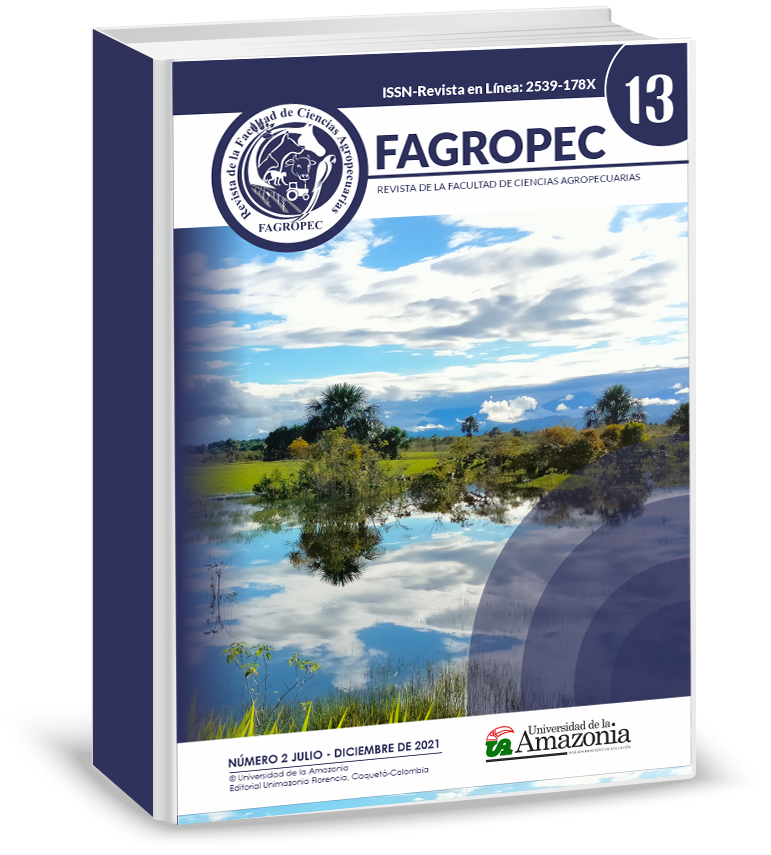Estudio de los componentes de producción del cultivo de café (Coffea arábica L.) variedad Castillo® en el departamento de Nariño
DOI:
https://doi.org/10.47847/fagropec.v13n2a3Palabras clave:
análisis de correlación, análisis de sendero, índice de área foliar, producciónResumen
El presente estudio tuvo por objetivo evaluar la relación de variables climáticas y de crecimiento con la producción del cultivo de café Variedad Castillo® en el departamento de Nariño. Se seleccionaron tres lotes (1ha) en tres diferentes rangos altitudinales por municipio (≤1600m, entre 1601 y 1800m, >1800m). Las variables registradas fueron, precipitación (PP), temperatura (TEMP) radiación fotosintéticamente activa (RFA), altura de planta (AP), diámetro basal del tallo (DBT), número de hojas (NH), número de ramas primarias (NRP), número de ramas secundarias (NRS), área foliar (AF), índice de área foliar (IAF), número de nudos por rama (NNR) y longitud de ramas (LR), las cuales, fueron contrastadas con la producción en g.pl-1 de café pergamino seco (CPS/PL). Se realizó un análisis descriptivo de las variables climáticas; análisis de varianza para variables de crecimiento y producción; análisis de correlación de Pearson entre las variables evaluadas y análisis de sendero de las variables que presentaron un mayor coeficiente de correlación. El registro general de las variables temperatura y precipitación no varió considerablemente entre altitudes dentro de cada municipio o entre ellos, mientras que la RFA, fue variable con respecto a las altitudes y municipios evaluados. El análisis de varianza, mostró diferencias estadísticas que evidenciaron el efecto de la altitud sobre los parámetros registrados. En el municipio de La Florida, el comportamiento de las variables que se diferenciaron estadísticamente con respecto al factor altitud fueron DBT, NH, AF, IAF; en el municipio de La Unión, las variables que presentaron diferencias estadísticas fueron para AP, DBT, NH, AF y IAF; en Sandoná, se presentaron diferencias estadísticas con respecto a las variables NH, AF y IAF y en el municipio de Consacá, se encontró diferencias para altitudes con respecto a la variable CPS/PL. El análisis de correlación mostró relaciones positivas entre altitud y variables de crecimiento especialmente en la Unión, y del rendimiento con AP, DT, NRP, LR y IAF, por otra parte, el análisis de sendero identificó a las variables AP, NRP y LR, como las de mayores efectos totales significativos sobre el CPS/PL en forma transversal; mientras que las variables IAF, NH y NRP presentaron los mayores efectos directos. En el municipio de La Florida las variables ALT, RFA, y TEMP presentaron los mayores efectos totales significativos sobre la variable dependiente CPS/PL.
Descargas
Referencias
Alvarado, G., Ochoa, H, (2006). Características fenotípicas de componentes de variedad Castillo en dos ambientes, Cenicafé, 57(2), 100-121, Disponible en: https://www,cenicafe,org/es/publications/arc057%2802%29100-121,pdf
Araujo e Silva Ferraz, G., Da Silva, F., De Carvalho, M. (2012). Análisis geoestadístico de rendimiento de frutos y fuerza de desprendimiento en café. Precision Agric 13, 76-89 En: https://link,springer,com/article/10,1007/s11119-011-9223-8
Arcila, J., Farfan, F., Moreno, A., Salazar, L., Hincapie, E. (2007), Sistemas de producción de café en Colombia, Chinchiná, Cenicafé, 309p. Disponible en: https://biblioteca,cenicafe,org/bitstream/10778/720/1/Sistemas%20producci%C3%B3n%20caf%C3%A9%20Colombia,pdf
Avelino, J., Rivas, G. (2013). La roya anaranjada del cafeto, Disponible en: https://hal,archives-ouvertes,fr/hal-01071036
Balladares, D., Calero, J. (2005). Efecto de la sombra y fertilización sobre el crecimiento, estructura productiva y calidad de café (Coffea arabica) vr, Costa Rica 95. Disponible en: https://repositorio,una,edu,ni/1969/1/tnf04b188,pdf
Balzarini, M., Gonzalez, L., Tablada, M., Casanoves, F., Di Rienzo, J., Robledo, C. (2008), InfoStat Software Estadístico, Manual del Usuario, Editorial Brujas, Córdoba, Argentina, 336p, Disponible en: https://www,researchgate,net/publication/283569520_Software_estadistico_InfoStat_Manual_de_usuario_Version_1/link/5f5f8745a6fdcc116410c707/download
Behrouz, M., DeEll, J. (2009). Correlation and path-coefficient analyses of ripening attributes and storage disorders in ‘Ambrosia’ and ‘Empire’ apples, Revista Postharvest Biology and Technology, Volume 51, Issue 2, Pages 168-173. https://doi,org/10,1016/j,postharvbio,2008,07,006
Bermúdez, L. (2016). Evaluación del crecimiento y producción en diferentes condiciones de siembra en café variedad Castillo, Tesis de Maestría, Universidad Nacional de Colombia, Medellín Colombia.
Bustamante, J., Casanova, A., Roman, N., Monterey, C. (2004). Estimación temprana del potencial de rendimiento en café (Coffea arabica L,) Var, Bramón I, Bioagro, 16(1): 3-8, Disponible en: http://www,ucla,edu,ve/bioagro/Rev16(1)/1,%20Estimaci%C3%B3n%20temprana,pdf
Camayo, G., Chaves, B., Arcila, J., Jaramillo, R. (2003). Desarrollo floral del cafeto y su relación con las condiciones climáticas de Chinchiná – Caldas, Disponible en: https://biblioteca,cenicafe,org/bitstream/10778/264/1/arc054%2801%29035-049,pdf
Castilla, N., Baeza, E., Papadopoulos, A. (2013). Greenhouse technology and management, CABI Publishing, 2a ed, 360p.
Centro Nacional de Investigaciones de Café – CENICAFE. (2011). Variedad climática y la floración del café en Colombia, Disponible en: https://www,cenicafe,org/es/publications/avt04072,pdf
Confalone, M., Castro, B., Ruiz, B., Sau, F. (2006). Componentes del rendimiento en leguminosas de grano con posiblidiades de ser utilizadas como forraje invernal en Galicia A, Pastos, XXXVI (2), 177-192.
De Carvalho, G., Guimaraes, M., Ferreira, B., Nogueira, A., Aparecido, A. (2006). Avaliação de produtividade de progênies de cafeeiro em dois sistemas de plantio, Ciência e Agrotecnologia, 30, 838–843. Consultado en: https://www,scielo,br/scielo,php?script=sci_arttext&pid=S1413-70542006000500003&lng=pt&tlng=pt
Federación Nacional de Cafeteros de Colombia –FNC. (2015). Comportamiento de la industria cafetera colombiana 2014, Bogotá.
Federación Nacional de Cafeteros de Colombia- FNC. (2010). Centro nacional de investigaciones de café - Cenicafé, Chinchina, Colombia.
Jasso de Rodríguez, D., Angulo, L., Rodríguez, G. (2001). Correlation and path coefficient analyses of the agronomic trait of a native population of guayule plants. Revista Industrial Crops and Products,Volume 14, Issue 2, pages 93-103, https://doi,org/10,1016/S0926-6690(00)00092-3
Laderach, P., Lundy, M.,Jarvis, A., Ramirez, J., Perez, E., Schepp, K. (2011). Predicted Impact of Climate Change on Coffee Suppy Chains, DOI: 10,1007/978-3-642-14776-0_42
Lince, L., Sadeghian, S. (2015). Producción de café (Coffea arabica L,) en función de las propiedades del suelo, en dos localidades de Quindío, Colombia, En: https://hemeroteca,unad,edu,co/index,php/riaa/article/view/1547/1844
McNougher, P. (2013). Insight special: Debunking coffee myths, Coffee division of ED&F Man, https://www,yumpu,com/en/document/read/22891202/insight-special-debunking-coffee-myths-bijdendijk
Moncada, M., Tovar1, E., Montoya, J., González, A., Spindel, J., McCouch, S. (2016). A genetic linkage map of coffee (Coffea arabica L,) and QTL for yield, plant height, and bean size, Tree Genetics & Genomes 12:1-17
Montoya, R., Hernández, A., Unigarro, M., Flórez, R. (2017). Estimación del área foliar en café variedad Castillo a libre exposición y su relación con la producción, Revista Cenicafé 68(19): 55-61
Moot, D. (1997). Theoretical analysis of yield of feld pea (Pisum sativum L,) crop using frequency distributions for individual plant performance, Annals of Botany, 79, 429-437
Ocampo, O,; Álvarez, L, (2017), Tendencia de la producción y el consumo del café en Colombia, Apuntes del CENES, Volumen 36 - Nº 64 julio - diciembre 2017, Págs, 139-165. DOI: https://doi,org/10,19053/01203053,v36,n64,2017,5419
Organización Internacional del Café –OIC. (2016). Informe del mercado de café- febrero 2016, Aumenta el consumo mundial de café, pero los precios siguen bajos, Londres: OIC , Disponible en: http://www,scielo,org,co/pdf/cenes/v36n64/0120-3053-cenes-36-64-00139,pdf
International Coffee Organization – OIC. (2021). Coffee prices rallied in April 2021 amid an anticipated decline in production and signs of economic recovery from covid-19 pandemic, https://www,ico,org/documents/cy2020-21/cmr-0421-e,pdf
Panhuysen, S., Pierrot, J. (2014). Barómetro de café 2014, En: Federación Nacional de Cafeteros de Colombia, 2014, Ensayos sobre economía cafetera, Año 27 No, 30 Enero - Diciembre, Formas Finales Ltda, 128 p, ISSN 2248-8731
Ramos, L., Criollo, H. (2017). Calidad física y sensorial de Coffea arábica L, variedad Colombia, perfil Nespresso AAA, Unión Nariño, Rev, Cienc, Agr, 34(2): 83 - 97, DOI: https://doi,org/10,22267/rcia,173402,74
Ramírez, V., Arcila, J., Jaramillo, A., Rendón, J., Cuesta, G., Menza, H., Mejía, C., Montoya, D., Mejía, J., Torres, J., Sánchez, P., Baute, J., Peña, A. (2010). Floración del café en Colombia y su relación con la disponibilidad hídrica, térmica y de brillo solar, Cenicafé, 61(2), 132-158.
Ramírez, V., Jaramillo, A., Arcila, J. (2013). Factores climáticos que intervienen en la producción de café en Colombia, En: Federación Nacional de Cafeteros de Colombia – FNC y Centro de Investigaciones en café - CENICAFÉ, 2013. Manual de cafetero Colombiano, Investigación y tecnología para la sostenibilidad de la caficultura, Tomo 1, FNC – CENICAFÉ. Bogotá, Colombia.
Rojas, E. (2015). La radiación PAR y su efecto en los índices de crecimiento, rendimiento y calidad del cultivo de tomate, Centro de Investigación en Química Aplicada, Tesis de Maestría. https://ciqa,repositorioinstitucional,mx/jspui/bitstream/1025/49/1/TESIS%20ELVA%20LILIANA%20ROJAS%20SANCHEZ%20final,pdf
Salazar, K., Arroyave, A., Ovalle, A., Ocampo, O., Ramírez, C., Oliveros, C. (2016). Tiempos en la recolección manual tradicional de café, Ingeniería Industrial, 37(2), 114–126.
Sauchyn, D., Upegui, J., Masiokas, M., Ocampo, O., Cara, L., Villalba, R. (2016). Exposure of Rural Communities to Climate Variability and Change: Case Studies from Argentina, Colombia and Canada, In W, Leal Filjo, K, Adamson, R, M, Dunk, U, Alzeiteiro, S, Illingworth & F, Alves (Eds,), Implementing Climate Change Adaptation in Cities and Communities, Integrating Strategies and Educational Approaches (pp, 23–38), Springer, http://doi,org/10,1007/978-3-319-28591-7
Silva, W., Brinate, S., Tomaz, M., Amaral, J., Rodriguez, W., Martíns, L. (2011). Methods to estimate leaf área in coffee, Enciclopedia Biosfera, 7,746-75,9
Suarez, J., Rodríguez, E.´, Duran, E. (2014). Efecto de las condiciones de cultivo, las características químicas de suelo y el manejo de grano en los atributos sensoriales de café (Coffea arabica L,) en taza, Acta Agron, (2015) 64 (4) p 342-348, doi: http://dx,doi,org/10,15446/acag,v64n4,44641
Turbay, S., Nates, B., Jaramillo, F.,Vélez, J., Ocampo, O. (2014). Adaptación a la variabilidad climática entre los caficultores de las cuencas de los ríos Porce y Chinchiná, Colombia, Investigaciones Geográficas, Boletín del Instituto de Geografía, 0(85), 95–112, Disponible en: http://doi, org/10,14350/rig,42298
Vaast, P., Angrand, J., Franck, N., Dauzat, J., Génard, M. (2005). Fruit load and branch ring-barking affect carbon allocation and photosynthesis of leaf and fruit of Coffea arabica in the field, Tree Physiology, 25, 753-760, https://doi,org/10,1093/treephys/25,6,753
Valencia, R., Ligarreto G. (2012), Correlación fenotípica y análisis de sendero para el rendimiento de soya (Glycine max (L) Merril), Revista Acta Agronómica, vol 61, Núm, 4, En: https://revistas,unal,edu,co/index,php/acta_agronomica/rt/printerFriendly/38137/40313
Publicado
Número
Sección
Licencia

Esta obra está bajo una licencia internacional Creative Commons Atribución-NoComercial-CompartirIgual 4.0.
























